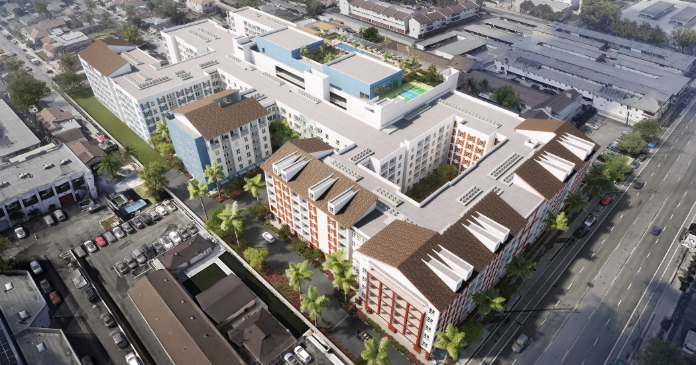Yardi Matrix released its August 2020 report on the multifamily rental housing market. The report shows that rent growth was positive for the second month in a row and that secondary markets are doing much better than urban core markets.
Rents up for the month, down for the year
The nationwide average rent in August rose by $1 from its July level to $1463 per month. On a year-over-year basis, average rents in August fell, with a decline of 0.3 percent. This matched last month’s decline.
For reference, the Bureau of Labor Statistics (BLS) reported that the CPI for all urban consumers rose 1.0 percent over the 12 months to July. The shelter portion of the CPI was up 2.3 percent in that time.
Annual rent growth leaders unchanged
The Yardi Matrix report focuses on the 30 largest metro areas and ranks them both by average rent growth over the last 12 months and also by rent growth in two sub-classes of apartments. These are the “renter by necessity” (RBN) class and the “lifestyle” (renter by choice) class. Because of the way the markets have been roiled by the different government responses to COVID-19, recent reports have also included data on month over month rent changes.
An interesting note in this month’s report is that, of the 132 markets that Yardi Matrix tracks, 108 of them performed better than the national average. That only 24 markets are performing worse than the national average implies that it is the poor performance of a few of the larger markets that is pulling the average down.
The top five major metro areas for rent growth in August were the same five as in July, although the order was rearranged a bit. The report identifies the top five as Indianapolis (3.5 percent), Inland Empire (3.1 percent), Sacramento (2.8 percent), Phoenix (2.8 percent), and Kansas City (2.7 percent).
The major multifamily housing markets with the lowest average annual rent growth were San Jose (-5.5 percent), San Francisco (-5.1 percent), Boston (-2.5 percent), Orlando (-2.2 percent), and Austin (-2.1 percent). Austin edged out the number 5 city on this list from last month, Los Angeles.
The top five major metro areas for month-over-month rent growth in August were Indianapolis, Raleigh, Sacramento, Portland and Nashville. None of these cities made the top five by this measure last month. The leading city for month-over-month rent growth last month, Las Vegas, saw its average rent fall from July’s level, pulled down by a decline in rents for lifestyle asset classes. By contrast, rents in Las Vegas for RBN asset classes were up for the month. The city actually saw the fourth strongest rent growth in that category in August.
Rents in the workforce housing (RBN) portion of the multifamily housing market again held up better in July than did the lifestyle portion of the market. Rents in the RBN portion of the market were up by 1.0 percent over the last 12 months, compared to a 1.6 percent decline in rents seen in the lifestyle product class.
Employment is the key
Ever since the COVID-19 related shutdowns started, the rental housing industry has focused on how many people have been paying their rent. Aided by generous supplemental unemployment payouts from the Federal Government, rent payment rates have held up surprisingly well. However, those supplemental unemployment payments ran out at the end of July and negotiations to renew this program have stalled. September rent payments will have to come from other sources of funds, with earned income being the most prominent source. Because of this, the Yardi Matrix August report focused on the employment situation.
The Yardi Matrix report was written before the August employment situation report was issued by the BLS. The BLS report showed a strong gain in employment with 1.4 million net additional jobs being added during the month. The unemployment rate fell by 1.8 percentage points to 8.4 percent. Despite these gains, there were 7.8 million more unemployed persons in the United States at the end of August than there were at the end of February 2020.
Yardi Matrix cited several metros where rents have held up relatively well recently. These metros are generally smaller with lower population densities and lower costs of housing than the large “gateway” metros. They are also often areas with the ability to attract tech jobs. The ones identified in the report include Huntsville, Boise, Fort Wayne, Portland, Maine and Grand Rapids. The report also identified several larger markets which showed recent improvement including Nashville, Raleigh and Portland, Oregon.
A special note again prefaced this month’s report stating that Yardi Matrix derives the information it presents in its monthly reports without accessing the transactional data collected for the properties managed with Yardi software. However, when they compared their results against that data, they identified certain cities where they continue to see a significant difference in the measured occupancy rates. These cities were Manhattan, Chicago, San Francisco, Los Angeles and Miami. In each case, the occupancy rates determined with reference to the data from the Yardi PMS software was 3 to 4 percent lower than that measured using Yardi Martix’s usual method.
The complete report discusses some of the smaller multifamily housing markets. It has more information about the larger markets including numbers on job growth, completions of new units and occupancy rates. It also includes charts showing the history of rent changes in 18 of the top 30 markets over the last 4 years. It can be found here.













